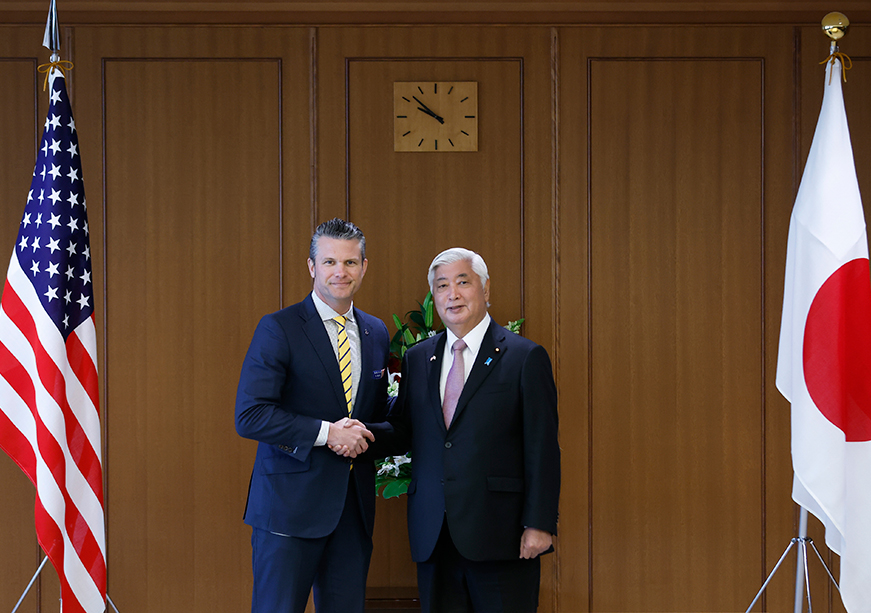
Image Source: Getty
Reports in late December 2024, showed that Russia's military developed a list of 160 potential targets in Japan and South Korea for a hypothetical conflict, based on secret documents dated between 2008 and 2014. The plans were created under Moscow’s assumption and response plans for a North Atlantic Treaty Organization (NATO)-related war expanding to East Asia. The target list includes 82 military sites such as command centres, air bases, naval installations, and radar facilities.
While war-gaming is a routine exercise undertaken by militaries worldwide, the Russian plans stand out due to two critical factors: the extensive scale and scope of the operations envisioned and the inclusion of precise details and locations of actual targets in Japan and South Korea.
Japan’s position and reaction to Russia’s strategic Threats
Specific targets in Japan include the Air Self-Defence Force radar base on Okushiri Island in Hokkaido, with detailed measurements of buildings and infrastructure. Civilian targets include the Kanmon Tunnel connecting Honshu and Kyushu islands, and a nuclear complex in Tokai Village, Ibaraki Prefecture. The leaked documents, although dated, are considered relevant to Russia's current strategic approach.
The leaked Russian military documents detailed plans to target Japan’s critical infrastructure, including nuclear power plants, underscoring the precarious security environment Japan faces in the Indo-Pacific. This revelation is likely to intensify Tokyo’s perception of Russia as a security threat, particularly as these plans target not only military installations but also civilian infrastructure.
The leaked Russian military documents detailed plans to target Japan’s critical infrastructure, including nuclear power plants, underscoring the precarious security environment Japan faces in the Indo-Pacific.
Japan has already been pursuing significant defence reforms under its National Security Strategy (NSS), with recent years seeing record defence budget allocations. The inclusion of nuclear power plants and energy infrastructure in Russia’s target list aligns with Japan’s vulnerabilities in critical infrastructure, necessitating a renewed focus on defensive measures to secure these facilities. Japan's acquisition of counter-strike capabilities, including long-range cruise missiles, reflects a strategic shift towards deterrence, signaling its preparedness to respond to potential aggression. Moreover, the focus on advanced missile defence systems like Aegis Ashore could gain additional urgency, given Russia’s plans to use Kh-101 cruise missiles, even though this missile system faces challenges in real combat scenarios.
Russia’s targeting of Japan’s civilian infrastructure also reinforces Tokyo’s role in the United States (US)-Japan security alliance. The US military’s forward presence in the region, combined with Japan’s increasing willingness to integrate its security strategy with allied operations, underscores the deepening defence collaboration between Tokyo and Washington. Additionally, although it is a long shot, Tokyo may push for enhanced trilateral cooperation with South Korea and the United States, particularly as the documents indicate overlapping Russian strategies against both countries. Despite historical tensions, Tokyo and Seoul have recently begun mending ties, recognizing the shared threat posed by Russia and China.
The unresolved territorial dispute over the Kuril Islands (referred to as the Northern Territories in Japan) is a potential reason for Moscow’s framing an offensive as a defence of sovereignty. Japan’s critical infrastructure and advanced military capabilities make it a strategic target for Russia to disrupt US alliances and regional stability. The plans also draw attention to Russia’s shifting strategic focus on the Indo-Pacific amid its deepening isolation from the West. While the plans are dated, given the globally volatile geopolitical situation, Tokyo needs to boost its preparedness in this potentially compounded threat environment.
Japan’s critical infrastructure and advanced military capabilities make it a strategic target for Russia to disrupt US alliances and regional stability.
South Korea’s reaction
For South Korea, the target list covers civilian and military positions of strategic importance. These include bridges, command and control bunkers, military headquarters and bases, and vital industrial sites such as Pohang Steelworks, based in Busan. While the revelation was a matter of grave concern due to the ongoing political turmoil in the country, it did not generate a similar political response as it did in Japan.
Nonetheless, South Korea has been concerned with Russia’s increasing strategic profile in the Northeast Asian region. Particularly after the signing of the Treaty of Comprehensive Partnership in June 2024, Moscow’s growing military and economic ties with North Korea have become an irritant in its bilateral ties with Seoul.
While there is a lot of apprehension about Moscow’s behaviour, taking into consideration the report and its military actions against Ukraine, Seoul’s primary concern towards Russia still stems from its deepening military ties with Pyongyang, rather than any sense of existential threat. Therefore, the objective has been to address the deepening partnership between the two, which has led to South Korea forging closer ties with the United States, its ally, and Japan. In recent years, its partnership with the US and Japan has systematically progressed via bilateral and trilateral mechanisms, through South Korea-Japan ties and the Trilateral security cooperation. Besides, South Korea has also elevated its mechanisms of cooperation and collaboration with NATO and Eastern European countries like Poland and Ukraine, particularly considering the Russian threat.
However, unlike Japan, the Russian threat narrative does not find many buyers across the political spectrum in Seoul. This is because of the absence of bipartisanship between the opposition and the ruling party when it comes to the perception of Russia and China posing a threat. With this differing perception of Russia as a serious national security threat under the democratic administration, the scope of cooperation between allies has traditionally been limited. Even though such information is perturbing for many in the country, it still occupies a low priority in its list of immediate threats.
South Korea has also elevated its mechanisms of cooperation and collaboration with NATO and Eastern European countries like Poland and Ukraine, particularly considering the Russian threat.
With political strife persisting in the country, the existing divide over foreign policy has come out in the open, with the opposition accusing the Yoon administration of practising a value-based diplomacy and ignoring the regional geopolitical balance.
Conclusion
Over the next four years, during Trump 2.0, the Russian challenge in Northeast Asia is likely to be addressed through a mix of military posturing, economic leverage, and diplomatic pressure. Emphasising burden-sharing, Trump might press Japan and South Korea to increase defence spending or develop independent military capabilities while bolstering the US military presence in the region, including naval deployments and intensified joint drills. While Trump has historically sought improved relations with Moscow, any overtures would likely focus on securing concessions beneficial to US interests. However, the US’, South Korea’s, and Japan’s differing threat perceptions of Russia will likely become a bone of contention, obstructing cooperation beyond a point.
Pratnashree Basu is an Associate Fellow, Indo-Pacific, with the Strategic Studies Programme and the Centre for New Economic Diplomacy at the Observer Research Foundation, Kolkata
Abhishek Sharma is a Research Assistant with the Strategic Studies Programme at the Observer Research Foundation.
The views expressed above belong to the author(s). ORF research and analyses now available on Telegram! Click here to access our curated content — blogs, longforms and interviews.




 PREV
PREV



